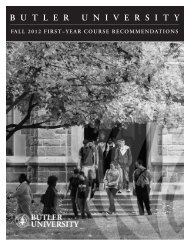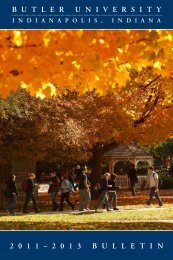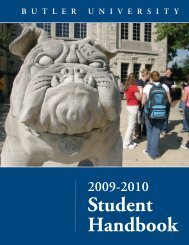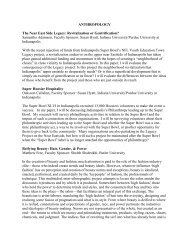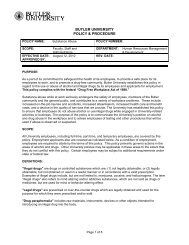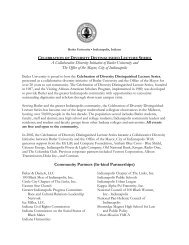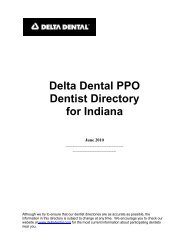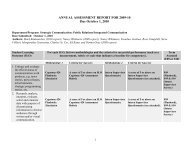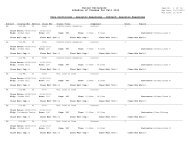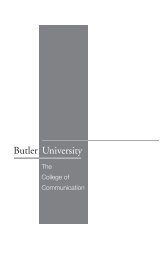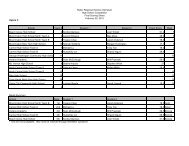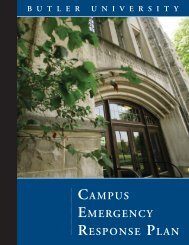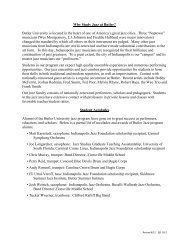ROWing Through Fall Creek - Butler University
ROWing Through Fall Creek - Butler University
ROWing Through Fall Creek - Butler University
You also want an ePaper? Increase the reach of your titles
YUMPU automatically turns print PDFs into web optimized ePapers that Google loves.
<strong>ROWing</strong> through <strong>Fall</strong> <strong>Creek</strong><br />
I. Introduction<br />
History of R.O.W.<br />
Over the past decade, Indianapolis has joined a growing number of cities that have become more aware<br />
of the environment and its impact on the way people live. The Livability Challenge in 2010 jump-started<br />
Indianapolis on the path to improve many environmental aspects of the city, including its waterways.<br />
Due to old infrastructure, Indianapolis faces a major problem with its combined sewage outflow (CSO)<br />
system. Its design causes Indianapolis’s CSO system to overflow into its water supply nearly every time it<br />
rains (Sabalow). While pollution on Earth has been increasing each year, public education about wildlife<br />
habitats, ecosystems and waterways has not (Worldometers). This lack of education has contributed to<br />
the general public not understanding where their water comes from. Indianapolis has effectively turned<br />
its back on the waterways. As a result, Indianapolis has created a problem that can wait no longer to be<br />
fixed. With no general understanding of watersheds, connectedness among Indianapolis’s waterways<br />
or the importance of healthy water, how will the city successfully improve its water quality and quality<br />
of life for the citizens of Indianapolis? Indianapolis community members have modified the Livability<br />
Challenge previously in place and created the Reconnecting to Our Waterways initiative (R.O.W). The<br />
focus of R.O.W is not to just unveil the waterways that have been lost over the course of Indianapolis’s<br />
growth as a city, but also to help the community reconnect to these waterways.<br />
The R.O.W. initiative grew out of the Livability Challenge sponsored by CEOs for Cities. The Livability<br />
Challenge asked cities to provide “access to art, good design, and nature every day” (CEOs for Cities).<br />
One of the initiatives that came out of the Livability Challenge was to reconnect to the White River<br />
in Indianapolis. Around the same time as the Livability Challenge, the Indianapolis Museum of Art<br />
commissioned an installation called “Flow: Can You See the River?” by artist Mary Miss (Indianapolis<br />
Museum of Art). This art installation increased consciousness of the White River in Indianapolis and<br />
spurred multiple neighborhood efforts to improve the watersheds. Indianapolis was ready to give back<br />
to its waterways and R.O.W. was born. R.O.W. is a grassroots movement involving multiple partners<br />
throughout the city who are interested in revitalizing the river (R.O.W.). It is not simply focused on improving<br />
the water quality itself, but takes a holistic approach to improving the waterways in Indianapolis<br />
and making the city more livable by highlighting watershed health and natural beauty.<br />
Project Overview<br />
The main purpose of R.O.W. is to promote safety, well-being, beauty, connectivity, pride, and respect<br />
within our communities. Six elements were designed to accomplish this: Aesthetics, Connectivity, Ecology,<br />
Economics, Safety, and Well-Being. These elements were thought to be most beneficial to the community,<br />
both now and in the future. The class worked with three of these elements: Connectivity, Aesthetics,<br />
and Ecology. When it comes to connectivity, the goal is for the neighborhood to have better<br />
access to their waterways. The idea is in a 10 minute walk or 20 minute bike ride from anywhere in the<br />
community that will bring residents to the waterway and to different destination points. Some factors<br />
that could influence the resident’s ability to do this are the existence of sidewalks and pedestrian lighting,<br />
all of which encompass what is called “Complete Streets”. For the second element, aesthetics, the<br />
goal is to provide art, nature, and beauty every day for everyone. Right now, many neighborhoods do not<br />
have access to this. The last element, ecology, will deal with a wide variety of things. It is already known<br />
how polluted the waterways are and what negative effects Combined Sewage Overflows (CSO) have on<br />
them. However, there are other things we can do to improve the ecological conditions in the area. Tree<br />
planting, invasive species removal, water quality, and educating people about the waterways will all go<br />
into improving the ecology.<br />
4



